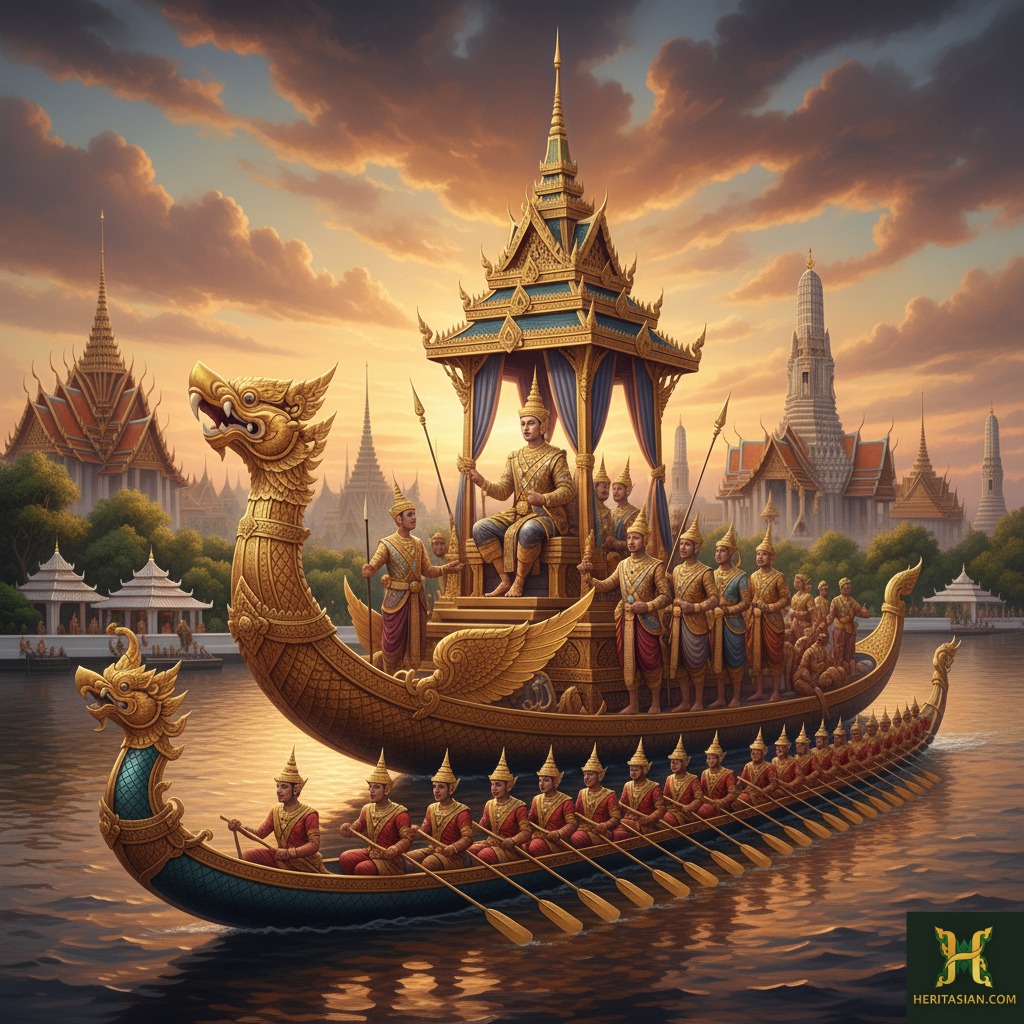In 1782, King Rama I founded the Chakri Dynasty and established the new capital, Krung Thep, on the eastern bank of the Chao Phraya River.
This was no random choice. The old capital, Ayutthaya, had been utterly destroyed by the Burmese in 1767. Rama I urgently needed a defensible site. Consequently, the location, known then simply as Bang Makok (Village of the Wild Plums), proved ideal. The vast Chao Phraya River provided a natural moat. Moreover, canals were immediately dug, carving out a protected, almost insular district. This became Rattanakosin Island, the original core of what we now know as Bangkok city.
The King set about recreating all the symbols of Siamese power. He modelled the new layout on the lost glory of Ayutthaya. This plan placed the centres of spiritual and political authority side-by-side.
The Spiritual Heart of Thailand
The new city’s spiritual heart beats fiercely within the walled compound of the Grand Palace. Built to house the King and his administration, this is more than just a royal residence. It’s the nation’s epicentre of faith. Inside, the Temple of the Emerald Buddha (Wat Phra Kaew) stands as the most sacred site in the kingdom. The small, highly revered statue, the Phra Kaew Morakot, serves as the kingdom’s spiritual authority of the monarchy and the royal family.
Just south of the palace walls, Wat Pho, famous globally for the gigantic, golden Reclining Buddha, is the original national headquarters for education. For centuries, this temple was a place where the public could learn herbal medicine and, critically, traditional Thai massage.
The military heritage is visible, too. Only a few structures from the original city defences survive. On the river’s edge, the octagonal Phra Sumen Fort stands as a magnificent stone sentinel. Built as one of fourteen forts to guard the city walls, it’s a reminder of the military anxieties that defined Bangkok’s inception.
To experience the river’s timeless flow and the historical energy of the late 19th century, explore our deep dive into the legendary Mandarin Oriental, Bangkok.
Modernisation, Railways, and the European Echoes
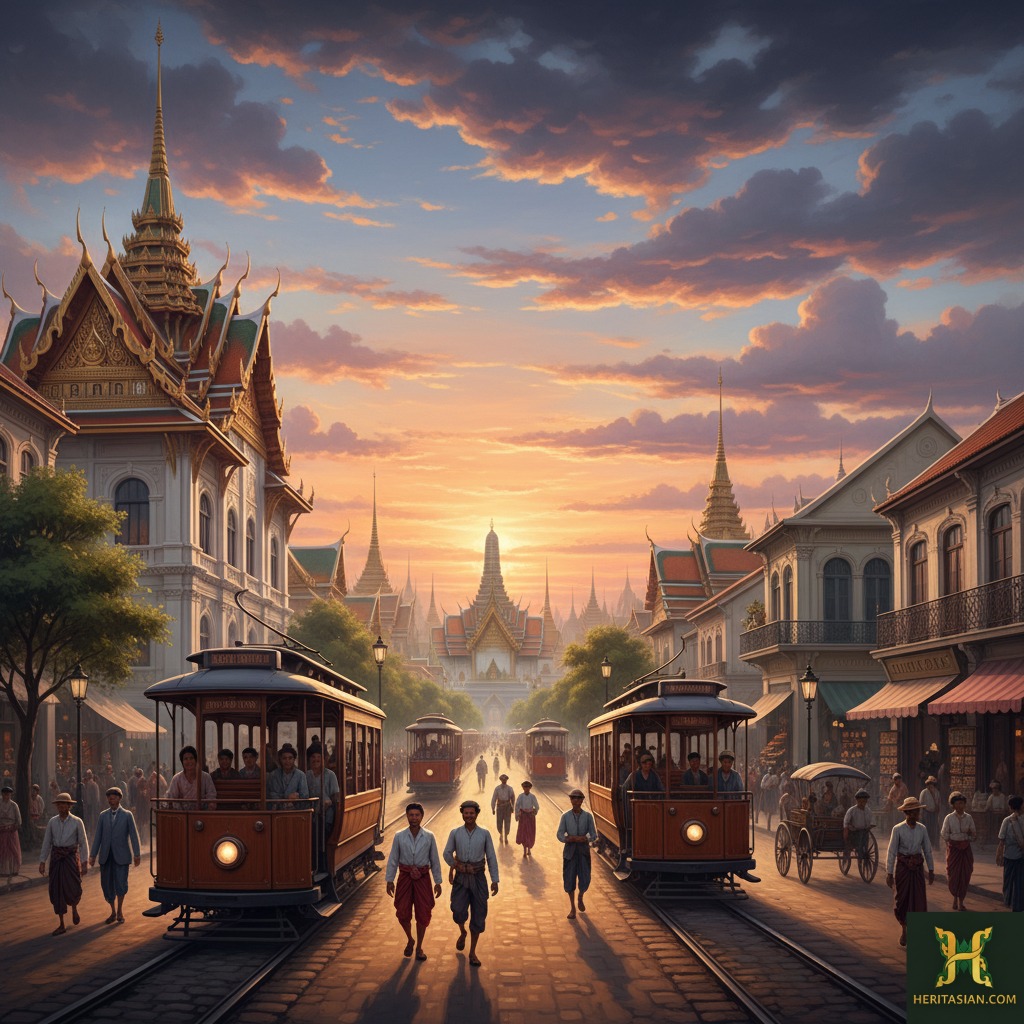
The greatest threat to Siam wasn’t conquest; it was irrelevance. By the mid-19th century, European powers had swallowed neighbouring kingdoms. King Mongkut (Rama IV) began a crucial, yet delicate process of diplomacy and reform. His successor, King Chulalongkorn (Rama V), accelerated the pace dramatically. He needed to prove Siam was a modern state worthy of independence.
This urgency drove massive change. King Rama V personally toured Europe. He returned with a vision: modern infrastructure and architecture would be his shield. This era saw Bangkok embrace the West while fighting to retain its soul. They built the first railways. They laid the first paved roads. Electric trams began clattering through the city.
The architectural result was fascinating. It produced the “Farang-Nai” style—Western on the outside, Thai within. Look at the royal buildings, and this fusion is clear. The King built new palaces outside the old Rattanakosin Island. This signalled a move toward modernity and less traditional, European-style urban planning.
The Vimanmek Mansion is the most celebrated monument of this age. Constructed entirely of golden teakwood, it’s the largest structure of its kind in the world. Yet, inside, it was replete with Victorian furniture and conveniences. It perfectly embodies the King’s balancing act: Thai materials and heritage serving a modern, royal lifestyle.
A New Urban Class Emerges
This period also saw the emergence of a new elite class and international commerce. Consequently, wealthy families and foreign traders built mansions and stately hotels. These buildings drew direct inspiration from Italian Renaissance or British colonial styles. In turn, they created a cosmopolitan flair that still defines pockets of Bangkok today.
This delicate balancing act, blending tradition with imported opulence, perfectly defined the hospitality of the time.
The refined Italianate style of the 1920s, a direct product of King Rama V’s foreign travels, lives on in river houses like Praya Palazzo.
The Golden Dragon: Cultural Fusion in Yaowarat
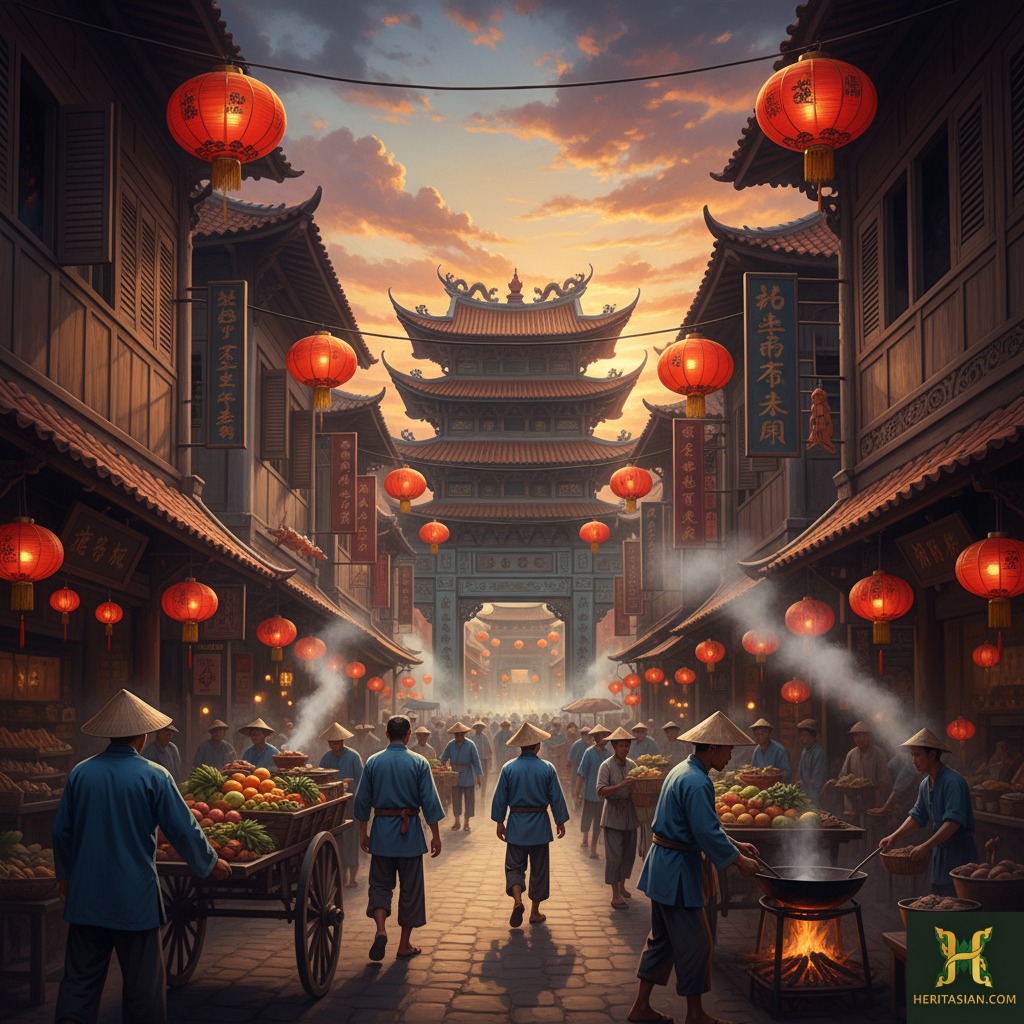
Bangkok’s establishment in 1782 required immediate compromise. King Rama I chose the strategic east bank for his palace complex. However, that land was already home to a settled Chinese merchant community. The King needed their loyalty and skills. He diplomatically ordered their relocation.
This move was momentous. The merchants shifted their thriving community just outside the new city walls. They established themselves along a muddy track, which would eventually become Yaowarat Road. This area, known today simply as Chinatown, soon became the city’s economic engine.
The community built a global trade network. They imported goods and exported the nation’s rice and tin. Their presence fueled the capital’s growth. They brought not just wealth, but a unique culture. Temples were built in the distinct Chinese-Buddhist style, whilst markets overflowed with exotic goods.
The wealth generated here remains. A powerful symbol of this prosperity is hidden within Wat Traimit. It houses the world’s largest solid gold Buddha image. For centuries, the statue was encased in plaster to hide its value from invaders. Its discovery in the 1950s was a stunning revelation, underscoring the hidden fortunes protected by this commercial district.
Architecturally, the area tells a clear story. The narrow, deep shophouses became the defining structure. These buildings were designed for commerce on the street level and residence above. They represent the industrious, efficient spirit of the Thai Chinese community. Today, places like Sampheng Lane remain chaotic arteries of trade. They link the past and the present.
Architectural Time Capsule: The Diverse Styles That Define Bangkok
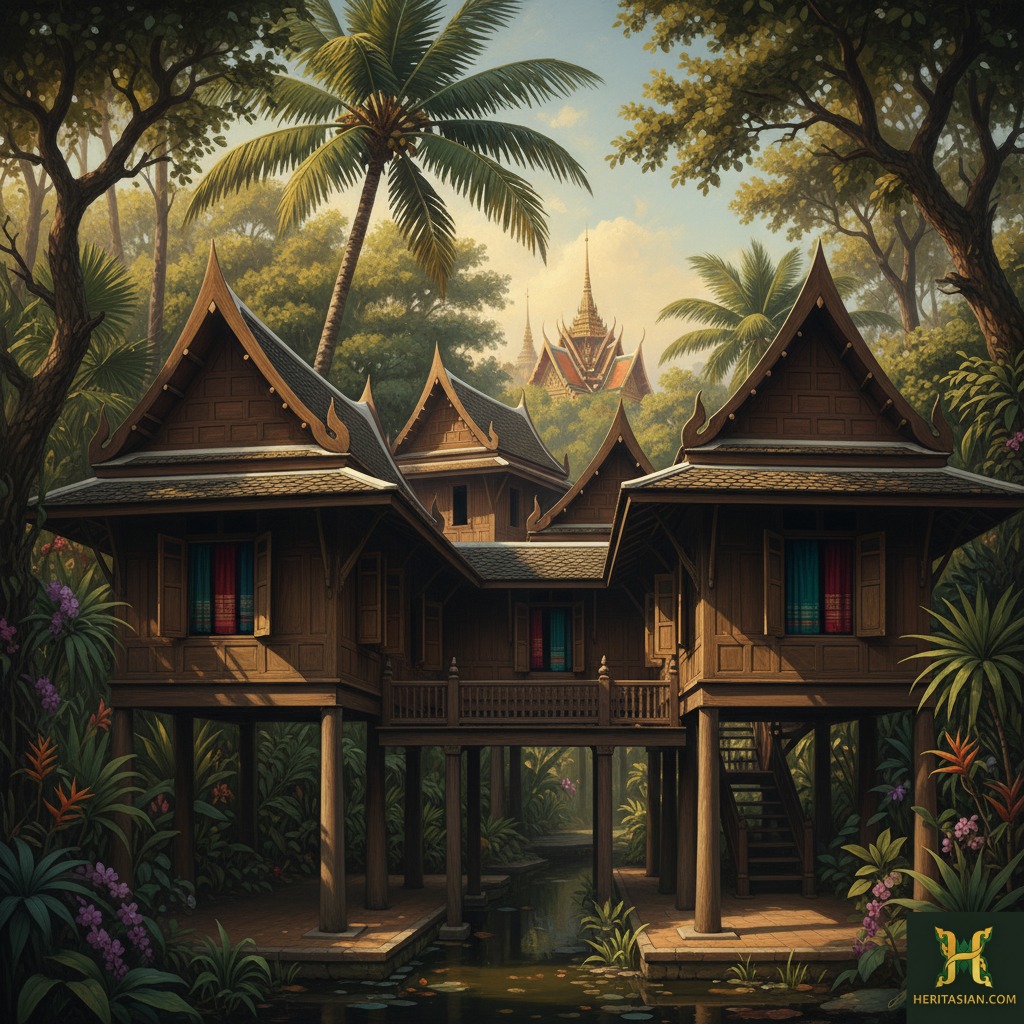
Bangkok is a layered city. Its architectural styles serve as a tangible timeline of its history and influences. We see traditional Buddhist artistry and also bold Western inspiration. This blend creates a unique visual story.
Early Rattanakosin architecture was characterised by the traditional Thai house. These structures were built primarily of teakwood. They stood on stilts for flood protection. They used a simple interlocking joinery system. This clever design meant they could be dismantled and moved quickly. This portability was essential to the indigenous way of life on the waterways.
This architectural wisdom found a champion in the American silk entrepreneur, Jim Thompson. After World War II, Thompson revived the dying Thai silk industry. He acquired several antique teak houses from various parts of Thailand and meticulously had these six structures reassembled into a single compound. Today, the Jim Thompson House stands as a magnificent museum. It’s a stunning example of preserved traditional Thai building craft, set amidst a tropical oasis.
The city’s history is equally visible in its government and commercial buildings. The late 19th and early 20th centuries brought significant European influence. Styles ranged from Victorian Neo-Classicism to elegant Art Deco. The latter swept the world in the 1920s and 30s. Bangkok embraced its clean lines and geometric symmetry.
You can still spot these historical structures today. Near the river, the decaying grandeur of the Old Customs House tells tales of that bygone era. It was once the entry point for foreign trade. The building reflects European colonial port architecture.
In the mid-20th century, a more modern, yet historic, sensibility took hold. This post-war era defined a new kind of luxury.
Beyond the Old Town, the 1950s Art Deco movement is perfectly preserved at the iconic The Atlanta Hotel.
Your Personal Passage to Bangkok’s Past
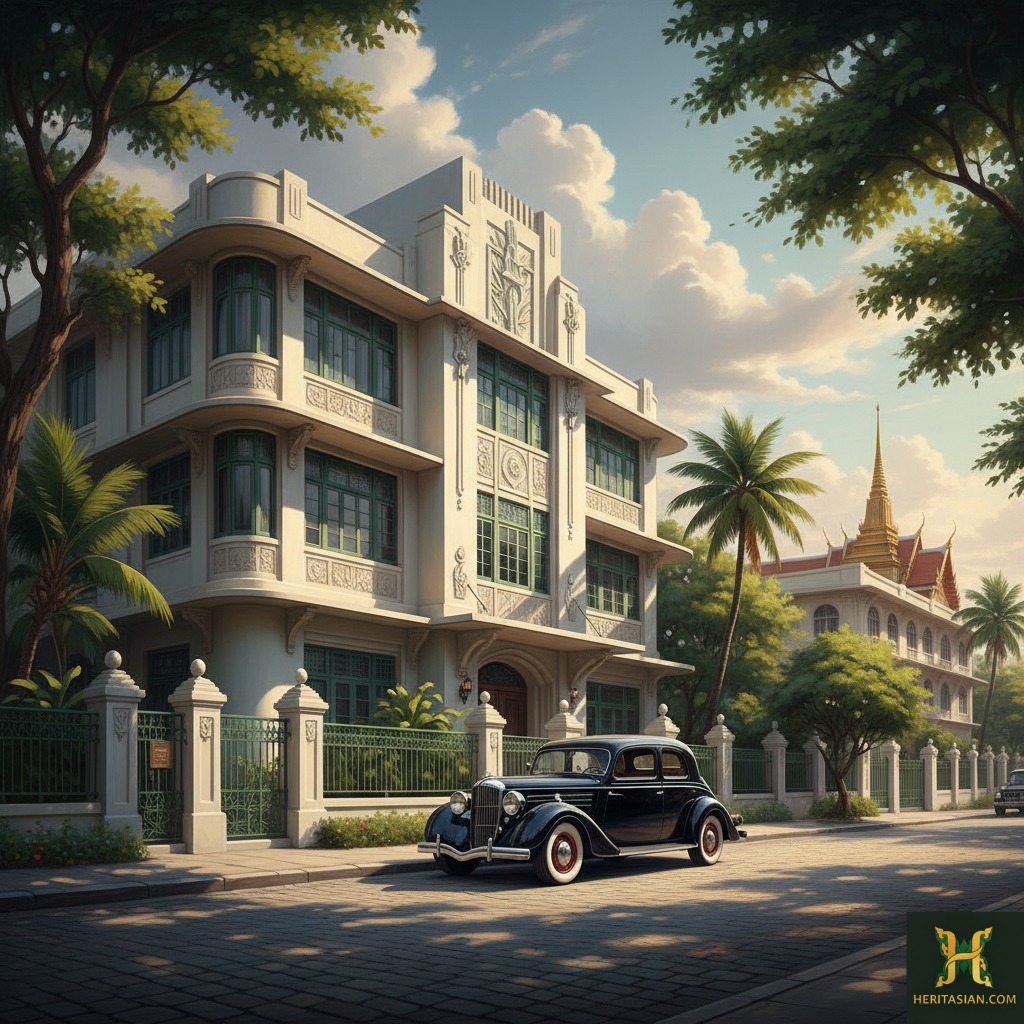
Bangkok is clearly more than a frenetic modern hub. It is a palimpsest. Every major artery, from the Chao Phraya to Yaowarat Road, is etched with history.
The capital’s story is one of resilience. Initially, it began as a strategic solution to a national disaster in 1782, and then successfully navigated the age of empire under King Chulalongkorn. It welcomed global trade, merging Thai tradition with Chinese dynamism and European style.
Today, the city invites immersion. Walk the quieter backstreets of Rattanakosin. Admire the preserved lines of a teakwood house. Observe the ancient canals still flowing beneath the bridges. These are the crucial sites where the true spirit of Krung Thep endures.
The ultimate way to honour this heritage is to engage with it personally. Seek out the hotels that refused to let the past fade. They offer more than just accommodation for the night. They provide a direct, tactile connection to the city’s rich narrative.
Plan your personal historical expedition. Let the walls of a heritage hotel tell you a story.
Bangkok Heritage FAQs
What are the two most sacred sites located within the original Rattanakosin core?
The two most sacred sites are the Grand Palace, the historical residence of the King and his administration, and the Temple of the Emerald Buddha (Wat Phra Kaew), which houses the revered Phra Kaew Morakot, serving as the kingdom’s spiritual authority.
What is the historical significance of the Rattanakosin Island district?
Rattanakosin Island is the original core of Bangkok city. King Rama I selected this site for its defensibility, with the Chao Phraya River serving as a natural moat. Canals were immediately dug to carve out this protected, insular district, where the centres of spiritual and political authority were established.
What is the u0022Farang-Naiu0022 architectural style?
The “Farang-Nai” style emerged during the modernisation period and signifies a fusion of Eastern and Western design. It is characterised by structures that are Western on the outside (such as European-style urban planning and classical facades) but retain a Thai sensibility within.
What is the history of Yaowarat (Bangkok’s Chinatown)?
Yaowarat was established because King Rama I strategically chose the land already occupied by the Chinese merchant community for his new palace complex. The King diplomatically ordered the merchants to relocate just outside the new city walls, where they established Yaowarat Road, which quickly became the city’s economic engine.
Which famous house serves as a prime example of preserved traditional Thai architecture?
The Jim Thompson House museum is a magnificent example. The American silk entrepreneur Jim Thompson acquired and meticulously reassembled six antique teak houses from various parts of Thailand into a single compound, thereby championing and preserving the dying Thai building craft.

